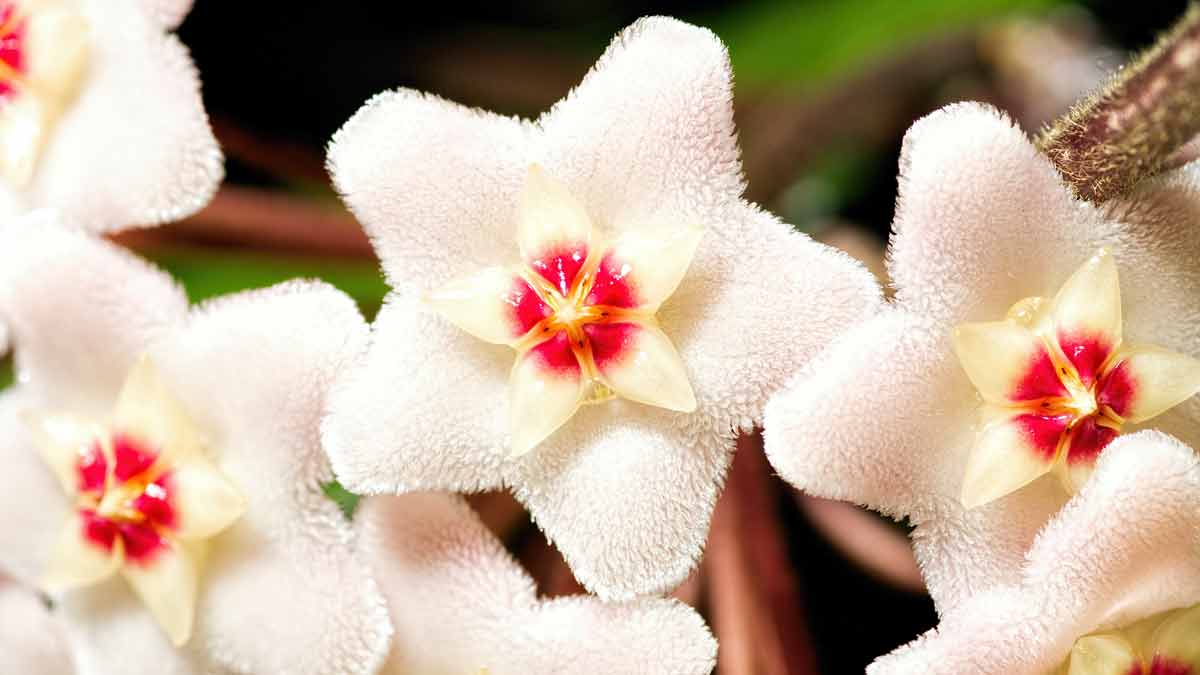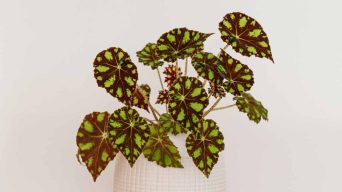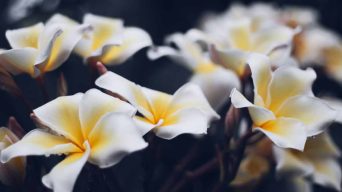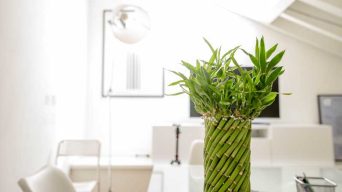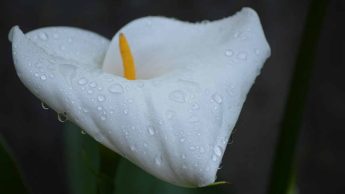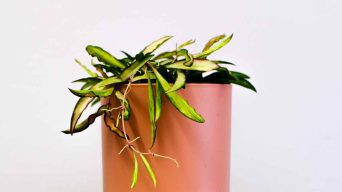To care for a Hoya plant, water it once a week and mist it twice a week during spring and summer, keeping the soil slightly moist. Let the top inch of soil dry out in fall and winter before watering once every two weeks. Hoya plants prefer bright, indirect light and well-draining soil.
Caring for Hoya plants can be a rewarding experience, as these stunning tropical beauties, also known as wax plants, boast eye-catching foliage and breathtaking blooms.
However, to ensure their optimal growth and health, it’s crucial to understand the appropriate watering frequency and techniques.
The frequency of watering Hoya plants is just one aspect of a complete care guide that includes factors such as soil type, humidity levels, and temperature variations.
This guide will delve into everything you need to know about keeping your Hoya hydrated while avoiding common pitfalls like root rot or underwatering.
Factors Affecting Hoya Plant Watering
In understanding the watering needs of Hoya plants, it’s essential to consider several factors.
These include the type of soil, humidity levels, temperature, size of the plant, and the pot it’s in.
These factors can significantly affect the amount and frequency of watering required to keep the plant healthy and thriving.
Therefore, it’s essential to consider these factors when caring for Hoya plants.
Type Of Soil
One crucial factor that impacts the watering needs of Hoya plants is the type of soil they are planted in.
A well-draining mixture containing ingredients such as peat moss, perlite, and orchid bark makes an ideal medium for these tropical epiphytes.
For instance, using a mixture of one part peat moss, two parts perlite, and one part orchid bark can create a perfect environment for Hoya plants to flourish.
Remember that if you choose a more compact or dense soil mix instead of a light and airy medium like this combination, you may inadvertently lower the frequency at which your plant needs watering.
Humidity Levels
Understanding the role of humidity in Hoya plant care is crucial for creating an optimal environment that promotes healthy growth.
As tropical plants, Hoyas thrive in moderate to high humidity levels, typically
ranging from 40% to 60%.
To maintain ideal humidity levels around your Hoya plants, consider utilizing a humidifier or placing a tray filled with water nearby.
Misting the leaves regularly is another effective method; however, be careful not to overdo it, which may lead to fungal problems.
An excellent example of a Hoya species that loves high humidity is Hoya obovata – its large waxy leaves benefit significantly from regular misting.
Temperature
Temperature plays a crucial role in determining how often to water Hoya plants.
In warmer environments, evaporation increases, causing the soil to dry out faster and necessitating more frequent watering.
It’s essential to be aware of seasonal temperature variations and adjust your Hoya plant care accordingly.
For instance, during summer, when temperatures are higher, keep an eye on the moisture levels in the soil and increase watering frequency as needed.
On the other hand, when temperatures drop significantly during winter or if you’re growing Hoyas indoors where air conditioning or heating may impact humidity levels and air circulation around the plant, it’s wise to reduce watering frequency while ensuring proper hydration for healthy growth.
Size Of The Plant
The size of your Hoya plant plays a significant role in determining how often you should water it.
Generally, smaller plants will require less water compared to larger ones.
This is because the larger the plant, the more leaves and stems it has, which means it will lose more moisture through transpiration.
For example, if you have a small Hoya Bella with few leaves and stems, you may only need to water it every two weeks.
Remember that each species of Hoya is unique and requires specific care.
Pot Size
The size of the pot plays a vital role in how often you should water your Hoya plant.
Choosing the right size pot is crucial as it affects soil moisture, root growth, and overall plant health.
If the pot is too small, it can cause your Hoya to become root-bound, making it difficult for the plant to absorb nutrients and moisture from the soil.
On the other hand, if you choose a large pot for a small Hoya plant, excess water might accumulate at the bottom of the container leading to issues like root rot.
Therefore, choosing a suitable-sized pot according to your Hoya plant’s growth stage and root size is essential for maintaining optimal watering needs.
Signs Of Underwatering And Overwatering
In gardening, identifying signs of underwatering and overwatering is crucial to maintain the health of your plants.
Underwatered Hoya plants display drooping or wilted leaves, while overwatered ones can suffer from yellowing leaves or root rot.
By paying attention to these symptoms, you can adjust your watering routine and ensure your plants receive the appropriate amount of water they need to thrive.
Symptoms Of Underwatering
Underwatering is a common issue that can occur with Hoya plants.
Symptoms of underwatering include dry and crispy leaves, curly or droopy foliage, and slowed growth.
The tips of the plant may also turn yellow, brown, or black.
It’s important to note that some Hoyas naturally have waxy leaves that can appear wrinkled or bumpy even when well-hydrated.
However, if you’re unsure whether your plant needs water, stick your finger in the soil to check for moisture levels.
Another way to assess watering needs is by lifting the pot; if it feels light compared to its normal weight after watering, it could indicate dehydration in your Hoya plant.
Symptoms Of Overwatering
Overwatering can be as damaging to Hoya plants as underwatering.
Some common symptoms of overwatering include yellow or brown leaves, soft and mushy stems, and a strong odor from the soil.
It’s important to remember that these symptoms are not exclusive to overwatering and can have other causes.
Therefore, checking the soil’s moisture level before taking action is crucial.
If you suspect your Hoya plant is overwatered, give it time to dry out completely and adjust your watering frequency accordingly.
Empty any standing water in the saucer under the pot.
Consider repotting into a well-draining soil mix with orchid bark for better drainage.
How Often To Water Hoya Plants
Determining the watering frequency for your Hoya plant is crucial to ensure it thrives.
Generally, Hoya plants need to be watered regularly during spring and summer with room-temperature water.
During fall and winter, when growth rates slow down, try reducing the amount of water you use on your Hoya plant or even just watering once every two weeks to once a month.
Checking your Hoya plant’s needs by sticking a finger into the soil can also help determine if it’s time to water them.
If the top inch feels dry, it might be safe to give them some moisture.
Watering Frequency For Hoya Plants
How often to water Hoya plants depends on humidity, temperature, soil type, and plant size.
As a general rule of thumb, water the plant when the top inch of soil feels dry.
Overwatering can lead to root rot and other fungal diseases, so it’s important to ensure that excess water drains away from the pot.
Some Hoya varieties prefer drier conditions than others.
For instance, Hoya carnosa compacta does well in drier soils.
In comparison, other species like Hoya kerrii prefer more moisture-retaining soils.
One method for checking if your Hoya plant needs watering is by sticking a wooden skewer or chopstick into the soil until it reaches about an inch deep.
Determining The Watering Frequency For Hoya Plants
Several factors need to be considered when determining the watering frequency for Hoya plants.
These include the pot and plant size, type of soil, humidity levels in the environment, and temperature.
Generally, you should only water your Hoya plants when the potting soil becomes almost completely dry.
Smaller Hoya plants in small pots or hanging baskets with faster-draining soils may require more frequent watering than larger plants in larger pots with slower-draining soils.
Higher temperatures and lower humidity also cause moisture to evaporate more quickly from the potting media, so you must increase the watering frequency.
Methods To Check For Watering Needs
To determine when your hoya plant needs watering, there are several methods you can use.
One of the easiest ways is to check the leaves’ plumpness by gently squeezing them between your fingers.
If they feel firm and turgid, the plant does not need water.
Another method is to stick your finger one inch into the soil near the pot’s edge to see if it feels dry or moist.
If it feels dry, it’s time to water; if it still feels moist from a previous watering, wait a few more days before checking again.
Additionally, a moisture meter can help you accurately measure how much moisture is in the soil and determine whether your plants need watering.
Best Time To Water Hoya Plants
The best time to water Hoya plants is when the top inch of potting soil has become almost completely dry.
This usually occurs every 7-10 days, depending on various factors such as the size of the plant, humidity levels, and temperature.
When watering Hoya plants, it’s best to use room-temperature water left in an open container for some time.
This allows any chlorine or other harmful chemicals in tap water to evaporate before being absorbed by the plant.
Additionally, it’s crucial to ensure proper drainage for your Hoya plant by using a well-draining soil mix and providing ample drainage holes at the bottom of your pot.
Watering Techniques For Hoya Plants
Here we’ll explore the most effective techniques for watering Hoya plants.
You will also discover the importance of proper drainage methods to maintain your plant’s health.
Following the best practices outlined in this guide ensures your Hoya plant thrives and flourishes in optimal growing conditions.
Best Practices For Watering Hoya Plants
To keep your hoya plants healthy, follow some best practices when watering them.
Firstly, ensure the pot has proper drainage to avoid water accumulation and root rot.
When watering, it’s best to do so slowly and evenly until the soil is moist but not overly saturated.
Timing is also crucial – watering your hoya plant earlier in the day rather than at night is recommended.
This allows excess moisture on leaves and stems from evaporating during daylight hours, which helps prevent fungal growth and other diseases.
Remember that overwatering can be as harmful as underwatering, so closely monitor how often you’re watering your hoya plant based on its needs and environmental factors such as humidity levels and temperature changes.
Techniques For Watering Hoya Plants
When watering your Hoya plants, using the proper techniques is important.
A good technique is to water the plant at its base and avoid getting water on the leaves or flowers.
Additionally, you should ensure that your pot has good drainage holes so that excess water can drain out.
Consider using a self-watering tray or creating small wells around each plant to ensure they receive enough hydration without overwatering them.
By following these simple techniques when watering your Hoya plants, you’ll be able to keep them healthy and thriving for years to come.
Proper Drainage Methods
Proper drainage is essential for the health of your Hoya plants.
As mentioned earlier, these tropical plants require well-draining soil that allows excess water to escape quickly.
Choose a pot or container with drainage holes at the bottom to ensure adequate drainage.
This will allow excess water to flow out when you water your plant.
It’s also important to avoid overwatering your Hoyas, leading to standing water in the pot and poor drainage.
Ensure not to let water sit in saucers beneath pots when watering, as it may cause root rot over time.
Water Quality For Hoya Plants
To ensure the health and longevity of your Hoya plants, it is crucial to consider the water quality you use.
Neglecting the importance of water quality can result in harm to your plants.
Here will explore the different types of suitable water for Hoya plants and treatment options available to improve water quality.
By understanding the significance of water quality in plant care, you can provide your Hoya plants with the optimal growing conditions they need to thrive.
Evaluating The Importance Of Water Quality
The importance of water quality cannot be understated when caring for Hoya plants.
Poor quality water can lead to various issues, such as leaf discoloration, wilting, and stunted growth.
To ensure the best possible health for your Hoya plant, it is crucial to evaluate the water quality you are using.
Sources such as an EPA monitoring report on water quality can provide valuable information on chemical and biological contaminants that may be present in your tap water.
Additionally, various treatment options, such as filtration systems or using distilled or rainwater, can significantly improve the overall quality of water used for watering your Hoya plant.
Types Of Water Suitable For Hoya Plants
Hoya plants are sensitive to the quality of water used for watering.
It is recommended to use room temperature rainwater, distilled water, or filtered water for watering Hoya plants.
Tap water often contains minerals and chemicals that can harm Hoya’s waxy leaves and roots over time.
The minerals in tap water can also accumulate in the soil, leading to buildup and poor plant growth.
Additionally, using cold or hot water directly from the tap can shock the plant’s system and cause damage.
When considering what type of water to use for your Hoya plant, remember that it’s not just about avoiding harmful substances; you need to provide optimal growing conditions so they thrive!
Treatment Options To Improve Water Quality
Water quality is crucial for the growth and development of Hoya plants.
Poor water quality can cause root rot and fungal diseases, harming the plant’s health.
One way to improve water quality is by using distilled or rainwater instead of tap water, which may contain chemicals like chlorine that are harmful to the plant.
Another treatment option is using a water conditioner or filtering system to remove impurities from your tap water.
These options can help ensure your Hoya plants receive clean, healthy water that won’t harm their roots or leaves.
Remember to avoid overwatering, as excess moisture can lead to poor drainage and promote bacterial growth in the soil.
Final Thoughts
Understanding how often to water Hoya plants is crucial for their health and growth.
Factors like soil type, pot size, humidity levels, temperature, and plant size all influence watering frequency.
Signs of underwatering or overwatering must be recognized to avoid root rot and other issues.
Water quality is also essential, with room-temperature aged water being the best option.
Proper drainage methods are necessary as these plants do not like sitting in stagnant water.

